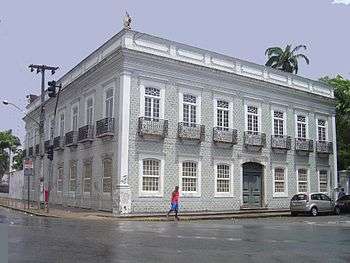Sobrado (architecture)
A sobrado is a type of house style building from the Portuguese colonial era, typical in Brazil and other former Portuguese colonies. It is a form equivalent to the Anglo-American townhouse, particularly the creole townhouse in Louisiana. Featuring typically two floors with a balcony, the sobrados were the residences of the urban notable people, notably in the former capital of Brazil, Salvador. They are also found in Cape Verde, particularly in São Filipe on the Fogo island,[1] and in Angola, in Luanda.[2]

.jpg)
A sobrado typically consists of two or more floors and with a relatively large built area. At the time of the colony Brazil the houses were the residences of the masters in the cities and marked the beginning of a timid urbanization of Brazil. In the previous period, the antagonism existed between the big house and the slave quarters, whereas the houseowners were opposed by the housekeepers, who were residences of the poorer strata of society. The expression arose naturally from the houses built in the cities of Minas Gerais (especially during the Gold Cycle), usually characterized by a topography typically called "sea of hills": the constructions were carried out from the highest level of the street, so that there was "a space" under the main floor of the building. Over time, this lower level came to be considered the ground floor, characterizing the "maisonettes".
Nowadays, the name of a house is given to any residence with more than one floor,[3] and it may even be applied to a commercial establishment.
See also
References
- History of Sobrados: Island of Fogo Archived 2010-09-18 at the Wayback Machine (in Portuguese)
- (in French) « Luanda, tournée vers le futur, néglige son patrimoine architectural », Buala
- "Tipos e padrões da arquitetura civil colonial – II". Coisas da Arquitetura. May 8, 2011. Retrieved June 7, 2016.
Further reading
- Sobrados e Mucambos [Sobrados and Mucambos] (1936) by Gilberto Freyre
- Henrique Teixeira de Sousa, Sobrados, lojas e funcos, Claridade, Mindelo, no. 8, 1958, p. 2-8